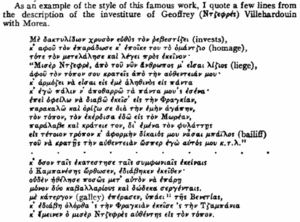Chronicle of the Morea facts for kids
The Chronicle of the Morea is a very old history book from the 1300s. It tells the story of how European Crusaders, often called Franks, came to live in mainland Greece. They settled in a part of Greece called the Peloponnese, which was known as Morea back then. This happened after the Fourth Crusade.
The Chronicle is a long text, with some versions having over 9,000 lines! It describes events from 1204 to 1292 (or even later, depending on the version you read). It also shares many interesting details about how the Principality of Achaia, a Frankish state in Greece, was organized.
Contents
Different Versions of the Chronicle
The Chronicle of the Morea exists in four main versions: Greek, French, Italian, and Aragonese. The Greek version is written in poetry, while the others are in prose (like a regular story).
The Greek Version
The Greek text is written in a special kind of poetry with 15 syllables per line. The lines have accents but don't rhyme. It uses the everyday Greek language of that time, and it even includes some French words!
There are two main Greek texts and three copies:
- The oldest text is in Copenhagen, written around the 1300s or early 1400s. It has 9,219 lines.
- A copy of this text is in Turin.
- A newer text is in Paris, written around the 1400s or early 1500s. It has 8,191 lines.
- Two copies of the Paris version are in Paris and Bern.
The Copenhagen text uses older language. The Paris text is simpler and has fewer foreign words. The person who copied the Paris version also removed some parts that were mean to Greeks. This made the text less harsh towards them.
The language in the Copenhagen and Paris versions is quite different. This shows how fast the Greek language was changing back then. The Copenhagen version tells stories up to the year 1292.
The French Version
This text is called "The Book of the Conquest of Constantinople and the Empire of Roumania and the country of the Principality of Morea." It tells stories up to the year 1304.
The Italian Version
The Italian version, called Cronaca di Morea, is a shorter summary. It was made later than the other versions and has some mistakes. It was based on the Greek text found in Turin.
The Aragonese Version
The Aragonese version is called Libro de los fechos et conquistas del principado de la Morea. It was put together in 1393. It used the Greek version and other sources. This version was made for a very important person named Jean Fernandez de Heredia, who was a Grand Master of the Knights Hospitaller. It covers events up to 1393.
Which Version Came First?
It seems that the very first version of the Chronicle of the Morea has been lost. We know that the Aragonese and Italian texts were made later. However, experts don't fully agree on whether the Greek or French text was written first.
Who Wrote the Chronicle?
The person who wrote the original Chronicle was probably a Frank (a European Crusader) or a gasmoule. A gasmoule was someone born from a French father and a Greek mother. The author seemed to really admire the Franks. They didn't think much of the local Greek people or the Byzantine Empire. However, the author did respect the Greek citizens of the Byzantine Empire, calling them Romans.
Why is the Chronicle Important?
The Chronicle is famous even though it has some historical mistakes. It gives us a lively picture of what life was like in the feudal communities of that time. It's also important because its language shows how quickly Medieval Greek was changing into Modern Greek.
One expert, Polet, explains that because the author admired the Franks and disliked Byzantine culture, the Chronicle of Morea didn't become a popular story after the Franks left Greece.
However, the Chronicle mentions many laws and ways of doing things in the Principality of Achaia. This makes it a very important source for understanding the time when the Franks ruled parts of Greece.
The Language of the Chronicle
The year 1453, when Constantinople fell, is often seen as the dividing line between Medieval Greek and Modern Greek. The Chronicle of the Morea is usually considered a Medieval Greek text. But, along with some other old Greek poems and songs, it's also seen as the beginning of modern Greek literature. It's a bridge between the old "Byzantine / medieval everyday language" and the "early modern Greek" literature.
First Printed Editions
The first time the Chronicle was printed was in 1840 by J.A. Buchon. This edition contained the Greek text from Paris. Buchon gave the book a different title: Βιβλίον της κουγκέστας του Μωραίως (Book of the conquest of Morea).
The second printed edition was the Greek text from Copenhagen, also published by Buchon in 1845. Later, in 1889, John Schmitt published both the Copenhagen and Paris texts side by side.
Translations
A translation of the Greek text was made in 1964 by Harold E. Lurier.
The Beginning of the Story
The book starts with a long introduction of 1,302 lines. The first three lines say:
- I will tell a tale to thee rehearse, a tale of import mighty
- And if attention you do lend, I hope the tale will please you
- T'is how the Frank by arms did gain the realm of fair Morea
See also
 In Spanish: Crónica de Morea para niños
In Spanish: Crónica de Morea para niños


